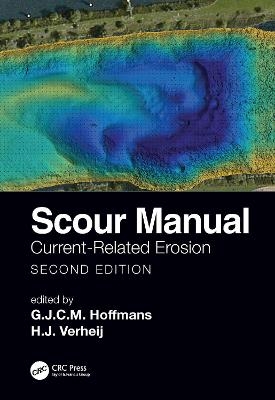
Scour Manual
CRC Press (Verlag)
978-0-367-67594-3 (ISBN)
Ever since the publication in 1997 the original Scour Manual has helped many practising hydraulic engineers to deal with scour processes near hydraulic structures. In recent years new insights, such as probabilistic calculations, offered new opportunities to design structures more economically. These new insights are included in this update of the original Scour Manual, which is focussing entirely on current-related scour. This manual provides the engineer with useful practical methods to calculate the dimensions of scour holes in the pre-feasibility and preliminary stages of a project, and gives an introduction to the most relevant literature.
This updated Scour Manual contains guidelines that can be used to solve problems related to scour in engineering practice and also reflects the main results of all research projects in the Netherlands in recent decades. The so-called Breusers equilibrium method has a central role, which can basically be applied to all situations where local scour is expected. The method allows to predict the scour depth as a function of time, provided that the available knowledge about scour at the specific structure is sufficient. For structures with insufficient knowledge available, alternative scour prediction rules are presented.
The treatment of local scour is classified according to the different types of structures. Each type of structure is necessarily schematised to a simple, basic layout. The main parameters of a structure and the main parts of the flow pattern near a structure are described briefly insofar they are relevant to the description of scour phenomena. New scour formulas for the equilibrium scour have been elucidated. Evaluating a balance of forces for a control volume, it is possible to develop scour equations for different types of flow fields and structures, i.e. jets, abutments and bridge piers.
As many scour problems are still not fully understood, attention is paid to the validity ranges and limitations of the formulas, as well as to the accuracy of the scour predictions. This information can also be used to carry out a risk assessment using a safety philosophy based on a probabilistic analysis or an approach with a safety factor. Moreover, the information on the strength of soils is extended and aspects are addressed such as scour due to shear failures or flow slides, that can progressively damage the bed protection which might lead to the failure of hydraulic structures.
This updated Scour Manual presents scour prediction methods and deals with practically related scour problems. Consultants and contractors were invited to provide case studies of realized projects, including the methods that were followed. These case studies will help with grasping the concept of scour by the flow of water. This manual provides the engineer with the latest knowledge and with case studies that show how to apply the formulas and their limitations.
Mr. Hoffmans has more than 30 years of professional experience in the field of scour, internal erosion, river engineering, dike and dam engineering and flood protection projects and has acted several times as Expert as well as Project Manager. He started his career as a research engineer regarding scour and erosion and the corresponding geotechnical processes. In addition, he examined the erodibility of both bed protections around hydraulic structures in non-uniform flow conditions, and revetments at dikes, for example grass covers. With this up-to-date knowledge he advised several clients all over the world with designing and assessing hydraulic structures. His design experience has been gained in various countries and covers the river training works and its geotechnical engineering and stability aspects. More specifically, this experience also focused on hydraulic structures such as estimating the dimensions of scour holes in relation to the magnitude of bed protection and the risks of shear failures and/or flow slides, considering several types of scour. The combination of research and project-related advice on site has increased his insight in the mathematical modelling of internal erosion phenomena, especially piping. He is author of several manuals and of more than 50 publications. Mr. Henk Verheij graduated in 1978 at Delft University of Technology in Civil Engineering (M.Sc.) and, subsequently, joined Delft Hydraulics (now Deltares) until his retirement in 2014. From 2006 till mid 2020 he was lecturer Ports & Waterways at the Delft University. Mr. Henk Verheij is a senior hydraulic engineer in the fields of dikes, embankments, hydraulic structures, ship-induced water motions, revetments and scour and its effects on the stability of bed protections, embankments and dikes along canals and rivers. He has experience with small-scale models as well as full-scale prototype investigations. He participated in research on dike breaches in cohesive materials, environmental-friendly protection methods, strength of grass dikes by overtopping tests, and reed as protection material. The expertise of Mr. Henk Verheij is being used for preparing guidelines and manuals for filter design, river dike revetments, scour, and the safety against flooding. He published over 50 papers, and is co-author of PIANC report 180 Guidelines for protecting berthing structures from scour caused by ships.
1. Introduction, 2. Design process, 3. Design tools, 4. Initiation of motion, 5. Jets, 6. Sills, 7. Abutments and groynes, 8. Bridges, 9. Case studies on prototype scale, References, Index
| Erscheinungsdatum | 06.04.2021 |
|---|---|
| Zusatzinfo | 56 Tables, black and white; 160 Illustrations, color |
| Verlagsort | London |
| Sprache | englisch |
| Maße | 174 x 246 mm |
| Gewicht | 420 g |
| Themenwelt | Technik ► Bauwesen |
| Technik ► Umwelttechnik / Biotechnologie | |
| ISBN-10 | 0-367-67594-3 / 0367675943 |
| ISBN-13 | 978-0-367-67594-3 / 9780367675943 |
| Zustand | Neuware |
| Informationen gemäß Produktsicherheitsverordnung (GPSR) | |
| Haben Sie eine Frage zum Produkt? |
aus dem Bereich


